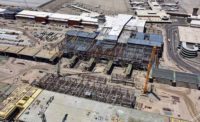
A royal opening on June 8 marked the on-time completion of a $325-million (€260 million) tunnel project to improve links between Brussels airport with the rest of Belgium and neighboring France and Germany. As rail services start through the new Diabolo project, the same construction team is on course to completing the larger Liefkenshoek rail tunnel in the port of Antwerp, 45 kilometers to the north.
Diabolo links Brussels airport with the also newly opened LN25 dual-track line to its north. Built by the government's railroad infrastructure manager Infrabel S.A., Brussels, the new line runs between Schaerbeek and Mechelen on the way to Antwerp and the Netherlands. Previously, the airport's rail connection was on the south, from the line to Germany.
The project includes twin 1.1-km-long bored tunnels under the airport, a 100-meter extension to the original 325-m-long station below the terminal and underground connections to the rail network.
Infrabel financed its Schaerbeek-Mechelen line itself but procured Diabolo's civil engineering through a 40-year public-private partnership. A consortium including units of Netherlands based Royal BAM Group N.V., Bunnik, France's Vinci S.A, Paris, and the Belgian contractor Smet-Tunnelling N.V., Dessel, is handling turnkey construction and maintenance. The design/build contract was signed in September 2007.
For the contractor, the underground track-switching chamber posed one of the project's major technical challengers, says project director Johan Mignon. The roughly 450-m-long chamber provides space for the two tracks emerging from the tunnel to split into four inside the station. The generally 20-m-wide chamber widens to over 30 m at one end to allow for future expansion.
Infrabel's decision to increase the design load of aircraft crossing the taxiway over the chamber came as a late surprise, says Mignon. As well as supporting the 740-tonne Airbus A380 super jumbo, the chamber roof must also carry overburden some two m deep, he adds. That meant scrapping plans to use reinforced concrete in favor of pre-stressed.
The 7.3-m-dia tunnel itself was relatively trouble free, says Mignon. The contractor used an 8.3-m-dia Herrenknecht mixshield tunnel-boring machine to drive the twin bores under the runways.
With Diabolo done, years of investment improving the airport's railroad links are nearing completion, says Infrabel spokesman Frédéric Petit. Packages of work yet to be done include the 1.25km-long Watermael-Schuman-Josaphat regional rail tunnel, south of the airport, scheduled for completion in 2015.
While Diabolo's TBM is long gone, two similar machines are still at work near Antwerp docks, in another PPP including much of the same construction team. Infrabel Liefkenshoek tunnel includes nearly six km of twin bored tunnels being built under a PPP signed in late 2008 with a consortium led by BAM and including Vinci. The new line is due to become operational a year from now.



Post a comment to this article
Report Abusive Comment